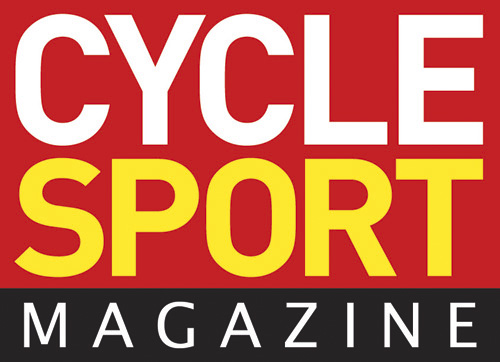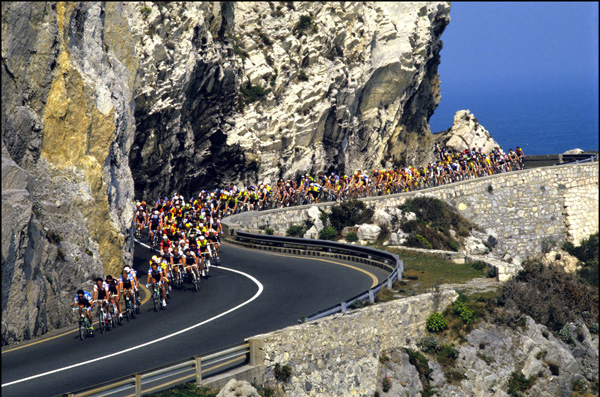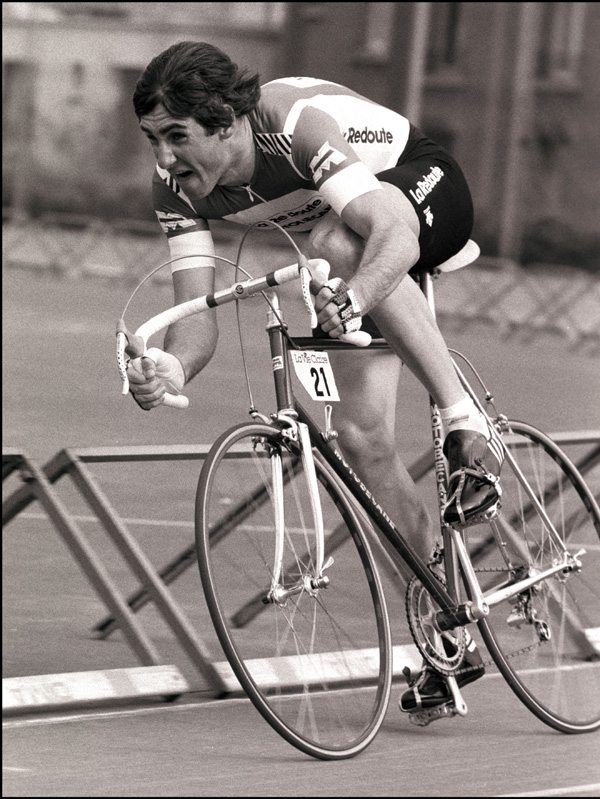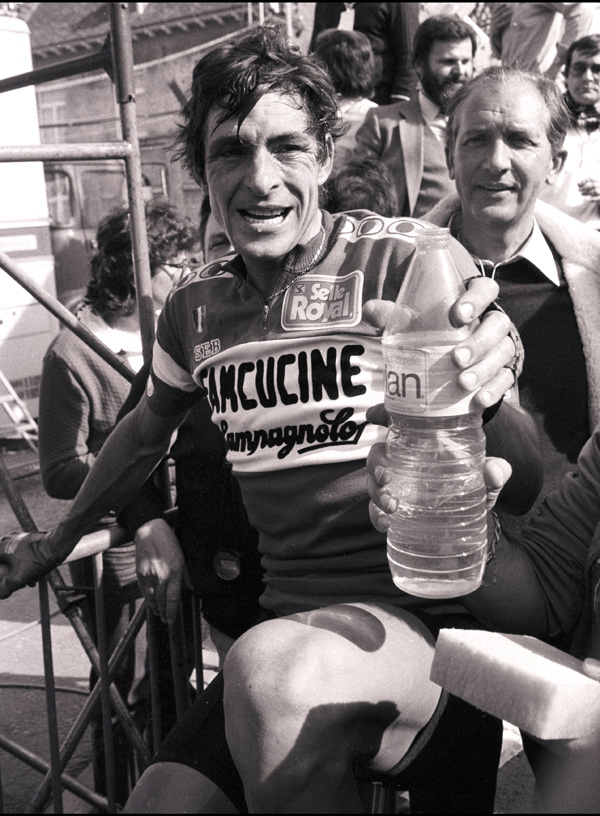Classic races: Milan-San Remo 1982

Early escapes in Milan-San Remo are usually brought to heel. But not in 1982...
Words by Lionel Birnie
Photography by Graham Watson
Vincenzo Torriani had a nickname. Toro. The Bull. It was a play on his surname but in some ways it reflected his personality too, because once Torriani, the organizer of Milan-San Remo, had made a decision, he proceeded with unstoppable force. So, after watching a supine edition of his race in 1981, he decided to act.
Fons De Wolf, the Belgian rider, had won the race by attacking near the top of the Poggio and descending with precision to hold off the bunch. It was a move with plenty of panache, but what frustrated the Italian press was that there had been so little action before that. The Italians had celebrated only two wins in 11 years at their early season race and the newspaper journalists had decided, in their usual bombastic fashion, it was because the corso had become too easy as professional cycling had developed. The riders were stronger and faster, the bikes lighter and more efficient. What had once been an epic survival of the fittest was in danger of becoming a procession.
So Torriani decided there should be another hill in the final phase of the race and identified the Cipressa as the ideal obstacle. The 5.8-kilometre climb came just after San Lorenzo al Mare. Someone in his office pointed out that the diversion would add around 20 kilometres to the race route, taking it over 300 in total, which was sure to raise objections from the riders. Torriani waved away the concerns. He had an answer to that. He’d simply print all the race literature, maps and routes with a more ‘acceptable’ distance. Sorted.
The sky was slate grey and the rain was cold and miserable as the huge peloton, almost 250 riders, gathered in Milan for the 1982 edition of the race. There wasn’t even much hope that the sun might shine down on the coast. The forecast was for a chilly, wet day in the saddle. You might think that all the talk would have been of the inclusion of the new hill, the Cipressa. These days the entire pre-race build-up would focus on the impact it may, or may not, have on the race. Riders, managers and pundits would all be asked their opinion. But barely anyone considered it. The race route was what the race route was. The riders would make the decisions. Torriani had included the climb in the hope it might favour the attackers, particularly the big Italian stars Giuseppe Saronni and Francesco Moser.
The latest race content, interviews, features, reviews and expert buying guides, direct to your inbox!
Tommy Prim, a Swedish rider with Giancarlo Ferretti’s Bianchi team, says he would be surprised if anyone went to look at the Cipressa before the race. “No, I don’t think so,” he says. “It’s not like today. Our team didn’t go to the Cipressa and the directeur sportif didn’t tell us anything about it. We knew there was a new hill but that was it. We just did the race.”
Then, as now, Milan-San Remo conformed to a pattern. An early escape would go and build a big lead before tiring and eventually getting reeled in before the finish. Then the favourites would come to the fore and it was a case of discovering which among them had the nerve to wait for the perfect moment to attack and the strength to pull it off.
“Milan-San Remo is the easiest race to ride but the hardest to win,” says Moreno Argentin, then a 21-year-old second-year professional who had announced his arrival the previous autumn with a fine second place in the Tour of Lombardy. “It’s a race where you can’t plan tactics, you have to live the moment and take opportunities when they come.”
The pace of the race in the final 50 kilometres meant that each of the favourites may have only one match to burn. Make the wrong move and that could be it, game over.
***

As they hung around in Milan, two French riders, one virtually unknown in his home country, let alone in Italy, tried to gather some information for their debut in La Classicissima. Marc Gomez was 26 years old and had thought that his chances of becoming a professional had passed him by. Then he finished third in the French amateur road race championship in 1981 and the small Wolber team signed him. Here he was, in his first season as a professional, enjoying himself and prepared to have a go. “I was in a small team and we didn’t have a team leader, so the important thing was to show myself and the sponsors of the team,” he says. “I remember I felt good. You don’t attack for no reason, I had good legs.” At the start, he spoke to a fellow Breton, Maurice Le Guilloux, who rode for Bernard Hinault’s Renault team. “He gave me some good advice,” says Gomez. “He said everybody wants to be in the break and that it would go hard and early and that if I wanted to be in the escape, I’d have to be at the front.”
Alain Bondue had been third in the individual pursuit at the Moscow Olympics in 1980. He was also reigning world professional pursuit champion and, at the age of 22, was beginning to make an impression on the road riding for the La Redoute team. A month before Milan-San Remo, he was second in the prologue at Paris-Nice, behind the specialist Bert Oosterbosch.
“There was quite a long way from the depart fictif and the depart reel, ten kilometres or so, which added to a race which was already long. I think we rode 307 kilometres that day,” he says. Despite adding extra distance by diverting the route off the coastal road up and over the Cipressa, Torriani had been reluctant to trim the neutralised procession through the centre of Milan.
Once the flag dropped, the pace was red hot. “It went very, very fast, right from the start and a big escape went, maybe 20 riders at first, including me,” says Bondue. “It wasn’t planned, but I came from a pursuiting background and one of my advantages was that I was able to go a bloc immediately.”
An Italian rider, Claudio Bortolotto, was a team-mate of Saronni in the Del Tongo team. “Another Del Tongo rider and I started it just to help make the race for Saronni,” says Bortolotto.
Gomez was in the move because he had been in the right place at the right time. “There was no grand plan to it. We had barely covered four kilometres and suddenly we were away.”
Vittorio Algeri, an Italian riding for Metauro Mobili-Pinarello, was also there. “I made a big error,” he says. “The escape went and I was in it but I remember thinking ‘In the last 20 years an early escape has never made it to the finish and I don’t want to throw away my chances’. So I sat up and gave Guido Bontempi a handsling as he was coming past.” Bontempi was on the rival Inoxpran team, but as Algeri drifted back to the bunch it was no skin off his nose to give a helping hand to a fellow Italian.
***
The group settled down and the race relaxed into its rhythm. No one in the bunch was too concerned and no one in the break thought they had any chance of staying clear for more than seven hours in the rain. “I never thought it would remain free,” says Bortolotto. “It’s difficult for an escape like that to arrive at the line but the chase behind was all broken up because of the rain and the cold.”
Once the break was established, the gap grew to around 11 minutes but no more. A common misconception of cycle racing is that the breakaway riders press on as hard as they can. In fact, once the gap has been gained they ease back and try to match the pace of the bunch. There are two reasons for this. Firstly, the break doesn’t want to get so far ahead that they cause the peloton to chase and secondly it conserves energy. Only if the bunch ups the pace will the break do the same.

As they approached the coast, so the capi, the little hills, loomed onto the horizon. “At first, Bondue wasn’t doing much work,” says Gomez. “He didn’t have to because he had a team-mate – Pascal Guyot – who was on the front a lot. We didn’t speak much because the weather was miserable, freezing cold and rain. We didn’t say much until we’d crossed the Turchino and there were eight of us left. Bondue came to me and said ‘let’s keep an eye on the Italians’. I knew him quite well, we’d done a training camp on the Mediterranean together two years previously, with the French amateur team.”
Bondue remembers his La Redoute team director, Philippe Crepel, pulling alongside him in the team car as they approached the hills. Crepel had waited to see what was happening on the front of the bunch before driving across the gap to the break. “Crepel told me Moser had got his team to chase. Some riders [in the break] thought it was over at that point but a few of us got organised and we rode the capi at virtually the same speed as the peloton. As they rode hard, so did we, to maintain the gap.”
On the coast, the rain eased and the temperature rose slightly. Crucially, they also found that they had a tailwind, which would turn out to be decisive. Gomez, with the big glasses that made him look more like an insurance salesman, was relieved it stopped raining because it was making it difficult to see. “I felt like my muscles were starting to work again,” he says. Marcel Boishardy, the Wolber team manager, was the man who had signed Gomez as a professional. “He handed me dry clothes and encouraged me a great deal. There wasn’t much advice he could give me, except ride steady and save some energy for the finish. I think he was just happy I was there.”
Behind them, the bunch had slipped into a state of complacency and the fact that none of the teams were willing to co-operate. Moser’s team wouldn’t work with Saronni’s. Argentin’s team wouldn’t work if the other two refused. At one point the Dutch and Belgians began to take up the chase but everyone stopped when Roger De Vlaeminck told his team, DAF Trucks, to stop. So they all sat and looked at each other. Then Saronni crashed on the descent of the Turchino and pulled out of the race. The cold and the rain meant that each of the big leaders was losing team-mates at an alarming rate. All of a sudden, the onus was going to be on the favourites to ride. “No one wanted to pull, everyone wanted the other team to do the work,” says Algeri. “Waiting, waiting, waiting.”
***
The Cipressa was a turning point, but not quite in the way Torriani had anticipated. The leading group had shrunk to just Gomez, Bondue and Bortolotto by now and the advantage was still seven minutes. With 30 kilometres remaining, Gomez attacked. It was the first time the Cipressa had been used but this was irrelevant to the Frenchman because he had no prior experience of riding Milan-San Remo. In fact, he’d rarely ridden a race of this length. He was entering the unknown.
“I got away on my own,” says Gomez “I remember turning round after the descent, looking back, and seeing Bondue and Bortolotto about 200 metres behind. I rode hard, but after a short while, I sensed somebody was coming up to me. I turned again and it was Bondue, who must have done a real number to get across to me, because Bortolotto was still 200 metres back. That was Bondue’s strength, he was a pursuiter.”

In fact, Bortolotto had tried to respond but couldn’t close the gap quickly enough. Bondue waited until the Italian tired, then rode across. “We were chasing, but I was doing all the pulling,” says Bortolotto. When we got near Gomez, Bondue attacked and I remained behind. My director told me to wait for the group behind and see if we could catch the two Frenchmen. I wanted to continue on, at least that way I could have finished third.”
By the time the remains of the bunch got to the Cipressa, they were beginning to panic. “The gap wasn’t coming down very quickly at all,” says Leo Van Vliet, a Dutch rider with the TI Raleigh squad. “I was supposed to be working for Jan Raas, but he was not having a great day and before the Cipressa he told me that if there was an attack, I should go with it.”
On the Cipressa the Italians, Moser and Argentin attacked. Vittorio Algeri missed out for a second time. “I went to the car to drop off my jacket but at that moment Moser and Argentin took off, so I was alone.”
Moser and Argentin split the group. Prim and Silvano Contini went with them but according to Algeri, he already knew they’d left it too late. “They would never have caught Gomez,” he says. “The key for the two leaders was the fighting between the big favourites and the tailwind on the coast. Perhaps if the team directors had told the riders to start pulling earlier it would have changed. They were thinking they would still have time to catch them because it’s such a long race, but they hadn’t figured on the tailwind.”
Van Vliet was one of the riders to go backwards on the Cipressa. The attack by Moser left him winded. “Ouf,” he says. “Prim and Moser were particularly fast. Argentin, I don’t think we knew too much about him because he was very young, but when they went on the Cipressa I couldn’t go. They were very fast."
Even now, the chasing group didn’t realise the situation. “I was keeping my eyes on Moser,” says Prim. “We had the guy on a motorcycle with a blackboard telling us the time [gap] but we were more interested in racing each other. We thought they were going to come back any minute. Surely on the Poggio, we would get them, so no one wanted to use too much energy. I had Silvano Contini, my team-mate, in the group so I did some riding, but not too much because we didn’t want to take Moser to the finish for free.”
***
All of a sudden, Gomez, the first-year professional began to think about the possibility of winning Milan-San Remo, one of the biggest races in the world. A year earlier, he’d been riding for a club team and occasionally the French amateur squad.
He and Bondue had opened the gap on Bortolotto, who was eventually caught by the Moser group. Towards the top of the Poggio, Gomez again pushed hard. “On the Poggio it was me and Marc and I knew one of us would win,” says Bondue. “I think I’d beat him in a sprint, so for him to win, he’d have to drop me, so that was that – I’d do no more work. I let him lead up the hill.
“At the top, it was important to be first into the descent, so I went past him, but on the first corner I slipped.”
The roads, still greasy from the day’s rain caused Bondue’s bike to skid from under him slightly. It caused him to hit the brakes and a gap opened. “It wasn’t serious because I’d been a few metres ahead and I got going again, so I was only a few metres behind,” says Bondue. “For me, no problem – I still thought I was going to beat him in the sprint. But then, on the second hairpin, I slipped again and I got frightened. The Poggio has a very technical descent. The first time I slipped, okay. The second time, I was scared. Gomez rode away, and the race was over.”
Gomez was not convinced of victory and put his head down. “I still wasn’t sure. Bondue had already showed he could close a gap. He was a pursuiter. It was only when I got to 300 metres to go that I knew I’d won.
“I’ve got two images that really stick with me. First, looking back near the top of the Poggio descent and seeing Bondue about 20 or 30 metres behind, then looking back a short while after and he was a long way behind.”
“But secondly, I remember how quiet it was as I rode down the Via Roma.” As Gomez approached the line most of the tifosi were asking themselves who this bespectacled rider in orange was. “Gomez? Who’s Gomez?”
“It was packed with Italian fans and they must have been waiting for one of their heroes – Moser or Saronni, instead they got an unknown,” he says. “There was probably more noise than I realised but my memory is that it was very quiet.”
As Gomez crossed the line, he raised his arm, then raised his index finger and pointed to the sky. “It was meant to be an homage to Eddy Merckx, who’d won the race seven times. I was showing that I’d won it once.”
Merckx congratulated the unknown hero on the podium but Gomez was overcome with disbelief. “This was one of the most beautiful races in the world – how could I have won it?”
As for Torriani, the Cipressa worked out eventually and would become an important battleground in subsequent editions. And he only had 12 months to wait for another Italian victor – Saronni won in 1983, wearing the rainbow jersey as world champion.
***
Cycle Sport's eyewitnesses
MARC GOMEZ
Milan-San Remo remained the biggest win of his career. He won a stage of the Vuelta and the French championship in a career that saw him ride as a domestique, including a spell for Bernard Hinault’s team. Now lives in Rennes.
ALAIN BONDUE
World pursuit champion and strong road rider who also finished third in Paris-Roubaix. Now works for Cofidis in opening new offices.
MORENO ARGENTIN
Italian Classics specialist who was world road race champion in 1986. Now works in construction
TOMMY PRIM
Swedish rider who finished runner-up in the Giro d’Italia in 1982, retired in 1986. Now aged 54, he lives in Sweden and works for a company that specialises in transporting valuable artwork around Europe.
CLAUDIO BORTOLOTTO
Del Tongo rider who won two Giro stages. Now owns a corn cooperative and is a bank vice-president.
LEO VAN VLIET
Dutchman who won Ghent-Wevelgem in 1983. Retired in 1986. Now aged 54, he works as race director for the Amstel Gold Race.
VITTORIO ALGERI
Italian domestique whose best result was a Giro stage win in 1978. Now a DS at Milram.
***
Milan-San Remo 1982 Top 10
1 Marc Gomez (Fra) Wolber in 7-04-12
2 Alain Bondue (Fra) La Redoute at 10sec
3 Moreno Argentin (Ita) Sammontana at 2-01
4 Francesco Moser (Ita) Famcucine
5 Tommy Prim (Swe) Bianchi
6 Claudio Bortolotto (Ita) Del Tongo
7 Silvano Contini (Ita) Bianchi all same time
8 Patrick Versluys (Bel) Boule d’Or at 2-42
9 Leo Van Vliet (Ned) TI Raleigh at 3-35
10 Walter Delle Case (Ita) Atala same time
Edward Pickering is a writer and journalist, editor of Pro Cycling and previous deputy editor of Cycle Sport. As well as contributing to Cycling Weekly, he has also written for the likes of the New York Times. His book, The Race Against Time, saw him shortlisted for Best New Writer at the British Sports Book Awards. A self-confessed 'fair weather cyclist', Pickering also enjoys running.